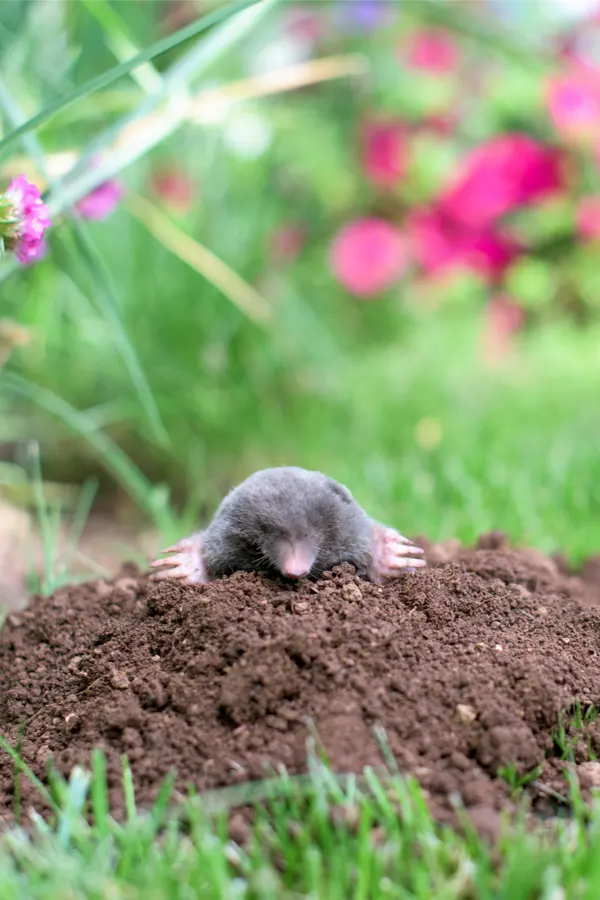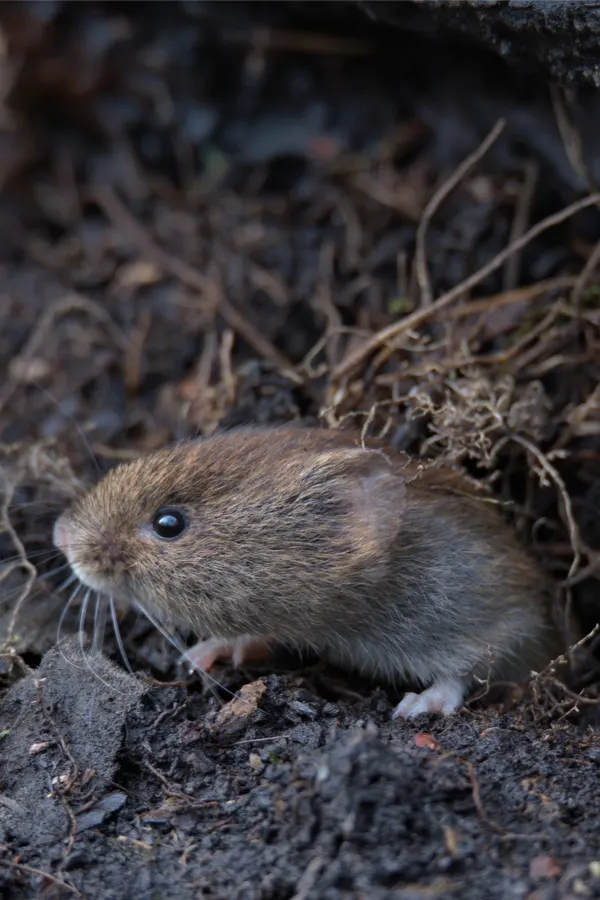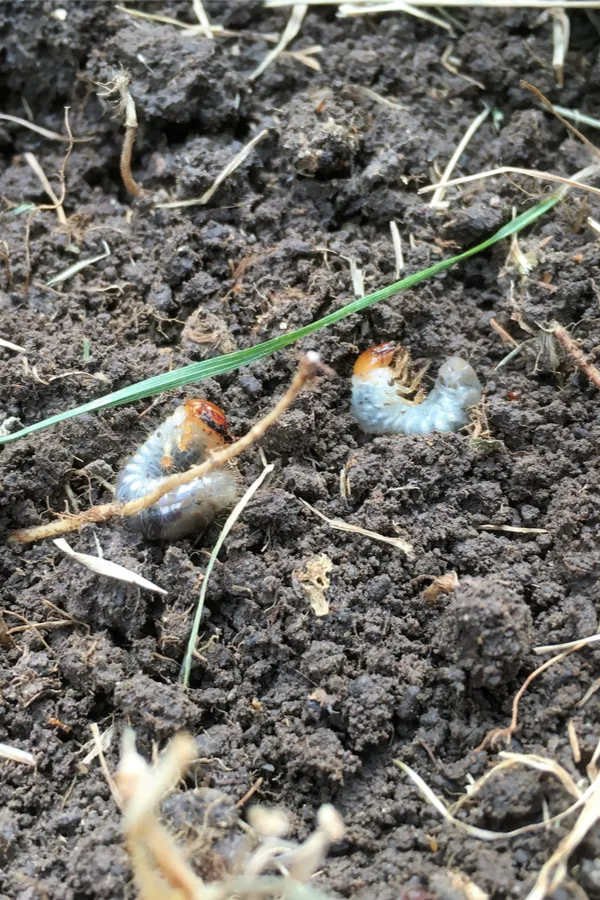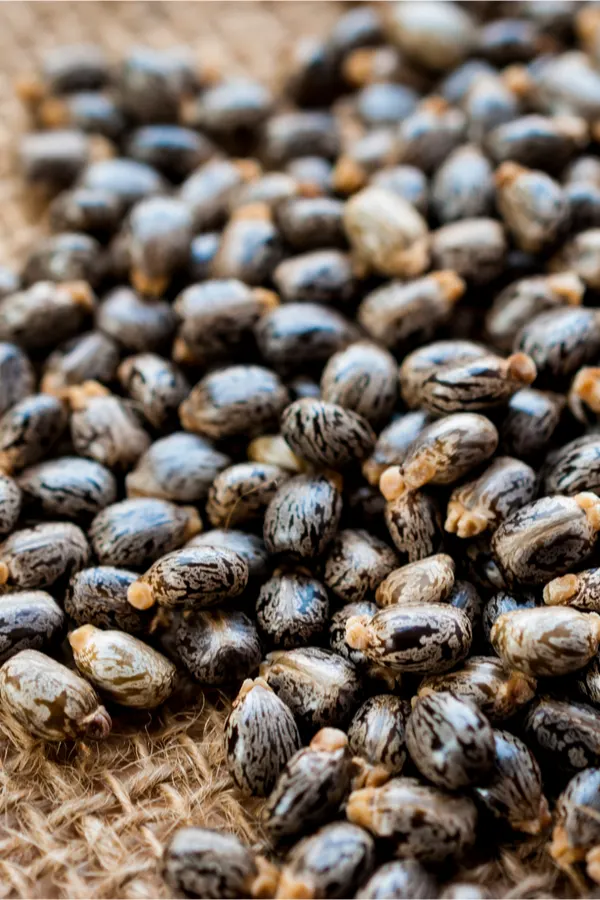If you are looking for how to keep ground moles out of your yard without using harsh chemical treatments, today’s article is for you. And it can even help you deal with vole problems too!
Both ground moles and voles cause a tremendous amount of damage to lawns, flowers and vegetable gardens. And although there are commercially available traps and bait, many are also dangerous for pets, children, and even adults.
So what is a gardener to do? Believe it or not, there are actually some pretty effective natural solutions to help to deter mole and vole populations. And they really do work in minimizing and even eliminating the damage moles and voles can do to a landscape.

The Difference Between Ground Moles And Voles
Keeping moles and voles in check all begins with first knowing which pest you are dealing with. Although they are often confused as one in the same, ground moles and voles are two entirely different animals – with two completely different appetites.
Ground Moles
Moles are insectivores, and exist solely to eat insects. Ground moles will not eat plants or the roots of plants. They can, however, damage lawns and plants in the process of looking for their lunch.
Moles work through the soil in long, underground tunnels in search of grubs, larva and worms. Where there are moles, there will be small mounds of conical-shaped dirt protruding from the ground. These are their entrance and exit holes.
How To Spot Vole Damage
On the other hand, voles are herbivores, and love feeding on plants. They can often be confused as a mouse or shrew, but live solely to feast on existing plant life. Of the two, voles can cause significantly more damage to the plants growing in your landscape.

When it comes to their diet, voles eat bulbs, roots, grass, leaves, and all types of plant foliage. They have even been known to eat the bark from trees and shrubs.
They love to find a location that provides plenty of cover to create their home. Because of this, they often live in or near brush piles, wood piles and high-grass or weedy areas.
How To Keep Ground Moles Out – And Voles Too!
Methods To Deter Ground Moles
When it comes to moles, it is important to understand that they are not entirely a pest. In fact, moles actually provide a bit of service for gardeners.
For starters, they devour huge amounts of grubs and larvae. One of their favorite just happens to be the dreaded Japanese beetle. They also feed on tomato hornworm larvae, as well as many other pests that can cause a gardener issues.

And believe it or not, the tunnels that they dig actually can help to loosen soil and aerate it. Of course, that is all well and good until they tunnel through your grassy yard, or happen to dig right through a row of crops!
So how can you keep moles out of your yard without spraying for the grubs? It all starts with sound and motion.
Deterring With Motion & Sound
Ground moles, and voles as well for that matter, do not like ground vibrations or sound. Both represent potential threats and or predators.
The more constant and active the motion, the better the results in keeping them away. For low-tech solutions, pinwheels placed around and in beds vibrate the soil and create motion and noise. A small radio turned on in the garden can also work in some cases.
Check Out Our Latest Garden Podcast:
But although both of those solutions can have some success, for us, using sonic solar repelling devices has been the ultimate solution. Especially when it comes to keeping them from tunneling around and through our garden!
Using Sonic Solar Repellents
Sonic repellent stakes emit frequencies and waves through the ground that help to repel both moles and voles. One of the best aspects of the stakes is that they are solar-powered. That means the stakes can be placed all around the landscape wherever there is a need to repel moles or voles.
The best part of all – installation is as easy as placing them into the ground! The stakes emit about 3 seconds of low frequency pulses every half-minute. The pulses penetrate through the soil and act as a huge deterrent to the pests that cannot stand the sounds and vibration of the pulse.

Each brand is a little different for coverage, but in general, each stake will cover a 25 to 50 foot radius of where it is placed. We use the Solar Mole Repellent, Ultrasonic & Solar Powered Gopher Repellent, which covers right around 40 feet. They have been incredibly effective in keeping the moles away from areas we are trying to protect.
Castor Beans / Oil And Spray – How To Keep Moles Out Of Your Yard Naturally
There are other natural methods you can try as well to repel moles. The scent of castor oil is one of the best. Many gardeners plant castor bean plants in their garden to keep moles out. ( Be cautious as they can be an invasive plant)
Many also believe that placing castor beans in the entrance holes causes ground moles to relocate. Onion and garlic placed in holes is another often-used remedy.
You can also create a natural repellent for lawn areas by mixing pure castor oil with water, and a few drops of liquid detergent.
To make, mix 10 ounces of castor oil with 2 gallons of water and a teaspoon of liquid detergent. Next, use a pump sprayer to apply to lawns and beds. Product Link : Pure Castor Oil . With this solution, you will need to re-apply after rains or watering to keep its effectiveness.
When It Comes To Voles..
With voles, the first line of defense is keeping their hiding areas to a minimum. Start by clearing out brush piles, and keeping grass and brush mowed down.
Also keep wood piles stacked and neatly off the ground a bit to inhibit easy hiding spaces. With no place to hide, they are an easy target for natural predators, and will often move away to more secure locations.
Using Gravel And Fencing
Voles work through shallow tunnels, and are not fond of working through gravel or rock. In fact, they don’t like it at all! Surrounding beds or garden areas with rock edging buried slightly below and above ground is one of the best natural solutions around.
Voles are notorious for digging up and devouring planted bulbs. Adding a bit of pea gravel in the holes around bulbs at planting time can help keep them safe as well. It also provides good drainage for the bulbs.

If that doesn’t work, mesh fencing or chicken wire buried below and above the ground at 4 to 6″ can work wonders in keeping voles out of beds and gardens.
Mesh and chicken wire fencing is also an excellent way to protect the undersides of raised beds, or on top of newly planted seedling that are just beginning to sprout.
Natural Predators
Finally, there is no better way to keep a vole population in check than with natural predators. Snakes, hawks and owls are all big vole hunters. But the best of all is the common cat.
Cats are excellent vole hunters and can aid greatly in keeping voles from multiplying into a major problem. They are, however, well known for gifting their hunting exploits at the back door.
Here is to finding the best way to deter ground moles and voles from invading your flower beds, garden and lawn this year – naturally! Happy Gardening – Jim and Mary.
Jim and Mary Competti have been writing gardening, DIY and recipe articles and books for over 15 years from their 46 acre Ohio farm. The two are frequent speakers on all things gardening and love to travel in their spare time.
As always, feel free to email us at thefarm@owgarden.com with comments, questions, or to simply say hello! You can sign up for our free email list in the subscribe now box in the middle of this article. Follow us on Facebook here : OWG Facebook. This article may contain affiliate links.

